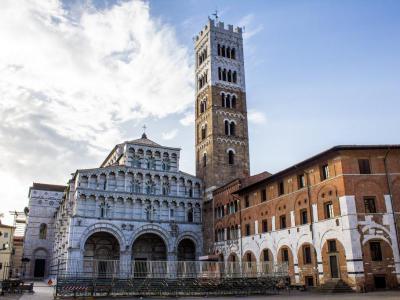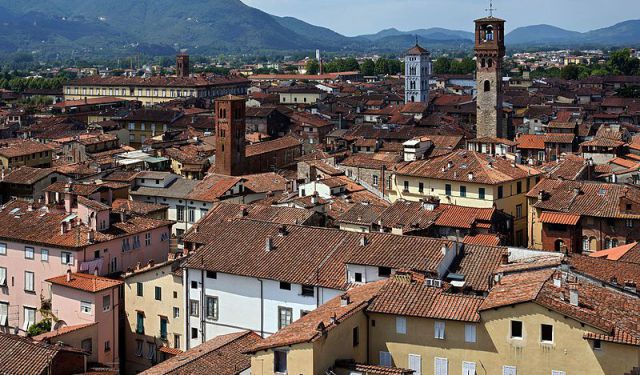
Duomo di San Martino (St. Martin's Cathedral), Lucca (must see)
It is said the Cathedral of Saint Martin was founded by San Frediano in the 6th century and rebuilt by Bishop Anselmo da Baggio in 1060. It came into its current form in the 12th and 13th centuries. Anselmo later became Pope Alexander II. In 1372, the apse of the church and the wall of the transept were completed. The style was Gothic.
The facade of the church is in three great arches surmounted by three rows of galleries filled with sculptures. To the right of the facade is the bell tower. It has a four-sided base and five rows of windows divided by pilasters. The crown is made of Ghibeline merlons.
The interior is laid out in a Latin cross with three naves. The two side naves are topped by false galleries. The central nave is contained in a semicircular apse with three large Romanesque windows.
The left aisle has a small chapel holding the sacred relic, the Holy Face of Lucca. The relic is a wooden crucifix with the image of Christ, supposedly carved by Christ's contemporary Nicodemus. It is said to have suddenly appeared in Lucca in 742 AD. The chapel itself was built by Matteo Civitali in 1484. Civitali was a sculptor of Renaissance Lucca.
Off the sacristy is the funeral monument of Ilaria del Carretto, made by the sculptor Jacabo della Quercia. Ilaria was the wife of Paolo Guinigi, Lord of Lucca until 1430. The Lady Ilaria died very young. Her image depicts her lying on the sarcophagus as if asleep, her faithful dog at her feet. Her ghost is said to haunt the Guinigi tower at night.
The Cathedral is also famous for its long association with members of the Puccini family who moved to Lucca from the mountain village of Celle in 1719. Giacomo Puccini’s personal involvement with the Duomo began when he was sent here to attend a seminary school.
The Cathedral, at one time, was a home of two magnificent organs: one from the 15th century and the other from the 17th. Little remains of these instruments today but the gallery and frontal pipes are still visible. From the early 1870s, Puccini took part in the Festival of Santa Croce at the Cathedral, first as a boy singer, then as a member of the choir, and later as a deputy organist.
The facade of the church is in three great arches surmounted by three rows of galleries filled with sculptures. To the right of the facade is the bell tower. It has a four-sided base and five rows of windows divided by pilasters. The crown is made of Ghibeline merlons.
The interior is laid out in a Latin cross with three naves. The two side naves are topped by false galleries. The central nave is contained in a semicircular apse with three large Romanesque windows.
The left aisle has a small chapel holding the sacred relic, the Holy Face of Lucca. The relic is a wooden crucifix with the image of Christ, supposedly carved by Christ's contemporary Nicodemus. It is said to have suddenly appeared in Lucca in 742 AD. The chapel itself was built by Matteo Civitali in 1484. Civitali was a sculptor of Renaissance Lucca.
Off the sacristy is the funeral monument of Ilaria del Carretto, made by the sculptor Jacabo della Quercia. Ilaria was the wife of Paolo Guinigi, Lord of Lucca until 1430. The Lady Ilaria died very young. Her image depicts her lying on the sarcophagus as if asleep, her faithful dog at her feet. Her ghost is said to haunt the Guinigi tower at night.
The Cathedral is also famous for its long association with members of the Puccini family who moved to Lucca from the mountain village of Celle in 1719. Giacomo Puccini’s personal involvement with the Duomo began when he was sent here to attend a seminary school.
The Cathedral, at one time, was a home of two magnificent organs: one from the 15th century and the other from the 17th. Little remains of these instruments today but the gallery and frontal pipes are still visible. From the early 1870s, Puccini took part in the Festival of Santa Croce at the Cathedral, first as a boy singer, then as a member of the choir, and later as a deputy organist.
Want to visit this sight? Check out these Self-Guided Walking Tours in Lucca. Alternatively, you can download the mobile app "GPSmyCity: Walks in 1K+ Cities" from Apple App Store or Google Play Store. The app turns your mobile device to a personal tour guide and it works offline, so no data plan is needed when traveling abroad.
Duomo di San Martino (St. Martin's Cathedral) on Map
Sight Name: Duomo di San Martino (St. Martin's Cathedral)
Sight Location: Lucca, Italy (See walking tours in Lucca)
Sight Type: Religious
Guide(s) Containing This Sight:
Sight Location: Lucca, Italy (See walking tours in Lucca)
Sight Type: Religious
Guide(s) Containing This Sight:
Walking Tours in Lucca, Italy
Create Your Own Walk in Lucca
Creating your own self-guided walk in Lucca is easy and fun. Choose the city attractions that you want to see and a walk route map will be created just for you. You can even set your hotel as the start point of the walk.
Lucca Introduction Walking Tour
Lucca is called many things: a city of arts, a city of churches, gardens, towers. Most of all it is known for its walls. From Roman times until now the walls have stood. It is the only city in Italy that has kept its walls intact.
The inner walled city is laid out in the ancient Roman grid plan. The Piazza San Michele is the site of the old forum. Bits of the Roman amphitheater can be found in... view more
Tour Duration: 2 Hour(s)
Travel Distance: 2.9 Km or 1.8 Miles
The inner walled city is laid out in the ancient Roman grid plan. The Piazza San Michele is the site of the old forum. Bits of the Roman amphitheater can be found in... view more
Tour Duration: 2 Hour(s)
Travel Distance: 2.9 Km or 1.8 Miles
Lucca's City Wall and Gates
As one of Italy's Città d'arte's (arts towns), Lucca is famous, among other things, for its well-preserved ancient walls encircling the historic center. From about 570 AD until 1847 the city had been the center of the Longobard administration and the capital of old Tuscany, and as such required a defense system to render it an impenetrable fortress.
Back in the Middle Ages, the... view more
Tour Duration: 2 Hour(s)
Travel Distance: 3.7 Km or 2.3 Miles
Back in the Middle Ages, the... view more
Tour Duration: 2 Hour(s)
Travel Distance: 3.7 Km or 2.3 Miles
Puccini's Lucca
One of the greatest musical talents of mankind, Italian composer Giacomo Puccini, was born and spent a substantial part of his life in the Tuscan city of Lucca. Today the legacy of Puccini resonates all over the world and even more so here.
Puccini's ancestors, also musicians, moved to Lucca in 1719. The future maestro was born in a house that had belonged to his family since 1815 – Casa... view more
Tour Duration: 1 Hour(s)
Travel Distance: 1.5 Km or 0.9 Miles
Puccini's ancestors, also musicians, moved to Lucca in 1719. The future maestro was born in a house that had belonged to his family since 1815 – Casa... view more
Tour Duration: 1 Hour(s)
Travel Distance: 1.5 Km or 0.9 Miles



